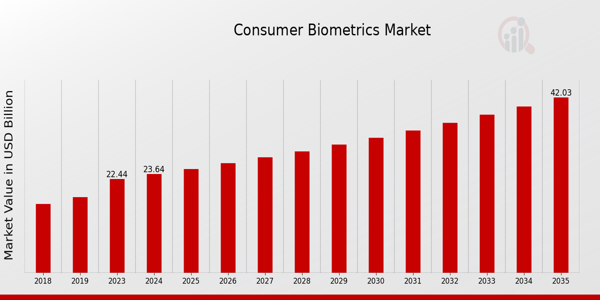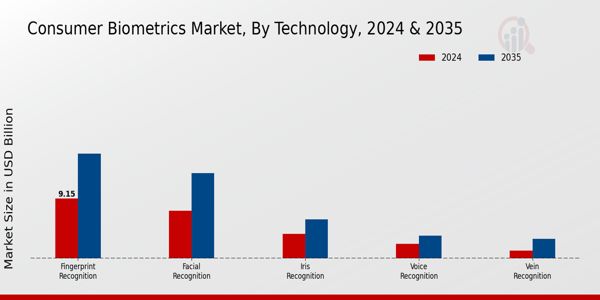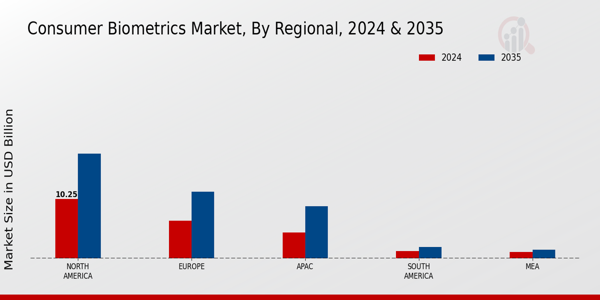Consumer Biometrics Market Overview
As per MRFR analysis, the Consumer Biometrics Market Size was estimated at 22.44 (USD Billion) in 2023. The Consumer Biometrics Market is expected to grow from 23.64 (USD Billion) in 2024 to 42.0 (USD Billion) by 2035. The Consumer Biometrics Market CAGR (growth rate) is expected to be around 5.37% during the forecast period (2025 - 2035).
Key Consumer Biometrics Market Trends Highlighted
Growing consumer worries about security and privacy are fueling the Consumer Biometrics Market's rapid expansion. People are looking for cutting-edge ways to protect their personal data as cyber dangers get more complex. Because customers prefer biometric authentication methods like fingerprints and facial recognition over traditional passwords, biometric systems' simplicity is a major driver in their proliferation.
The need for safe and convenient identification techniques has also increased due to the growth of e-commerce and mobile payments, which has supported the market's growth. The consumer biometrics industry offers a wealth of chances for innovation and advancement. As technology continues to evolve, companies can explore new biometric modalities beyond traditional methods, such as behavioral biometrics and voice recognition. Integrating artificial intelligence and machine learning can enhance the accuracy and efficiency of biometric systems, presenting a pathway for businesses to differentiate themselves in a competitive landscape.
Furthermore, the growing demand for biometric solutions in various sectors, including retail and healthcare, provides ample prospects for market players to establish partnerships and expand their service offerings. In recent times, the trend toward contactless biometric solutions has surged, influenced by the global pandemic that emphasized hygiene and safety. End-users increasingly favor touchless systems that reduce physical contact, leading to the development of advanced technologies like iris scanning and voice recognition. The integration of biometric systems into everyday devices such as smartphones and wearables is also becoming commonplace, making these technologies more accessible to the general public.
Overall, the combination of growing security concerns, technological advancements, and evolving consumer preferences is reshaping the landscape of the Consumer Biometrics Market, making it a vital area of focus for businesses and investors alike.

Source: Primary Research, Secondary Research, MRFR Database and Analyst Review
Consumer Biometrics Market Drivers
Increasing Demand for Enhanced Security Solutions
The rising concern over security breaches and unauthorized access to sensitive information has significantly boosted the demand for advanced security solutions. In the Consumer Biometrics Market, consumers are increasingly seeking reliable methods to protect their personal and financial information. Traditional security measures, such as passwords and PINs, are becoming less effective due to the prevalence of cyberattacks and identity theft. Biometric authentication methods, including fingerprint recognition, facial recognition, and iris scans, offer a more secure alternative that is difficult to replicate or forge.
This shift toward biometrics is driven by the growing awareness regarding personal data security and the need for robust solutions that ensure privacy and protection. Companies and service providers are also integrating biometric systems into their platforms to enhance user trust and confidence, making it a crucial driver for growth in the Consumer Biometrics Market. As technology continues to advance, the adoption of biometrics is expected to become mainstream, further elevating its importance in personal and enterprise-level security strategies.
Technological Advancements in Biometric Systems
The Consumer Biometrics Market is witnessing substantial growth due to the rapid advancements in biometric technologies. Innovations in the accuracy and efficiency of biometric systems have resulted in more effective and user-friendly applications. For instance, advancements in artificial intelligence and machine learning have improved facial recognition algorithms, enhancing their reliability under various conditions. Similarly, the shrinking size of biometric sensors allows for seamless integration into everyday devices, such as smartphones and laptops.
These technological improvements are making biometric systems more accessible and appealing to consumers. As a result, consumers are more likely to adopt biometric solutions, leading to increased market growth.
Rising Adoption of Biometric Payments
There is a growing trend towards biometric payment systems that leverage authentication methods like fingerprint scanning and facial recognition. The Consumer Biometrics Market sees a surge in contactless payment solutions that prioritize convenience and security.
Consumers are increasingly favoring biometric payments due to their speed and the added layer of security these methods provide. Retailers and financial institutions are also adopting these systems to enhance customer experience and reduce fraud.
This trend indicates that consumers value not only the convenience of biometric payment systems but also the security they offer, making it a substantial driver of growth in the Consumer Biometrics Market.
Consumer Biometrics Market Segment Insights
Consumer Biometrics Market Technology Insights
The Consumer Biometrics Market was poised for significant growth, particularly within the Technology segment, reflecting a strong demand for biometric solutions in consumer applications. The market segmentation revealed a diverse range of technologies, with Fingerprint Recognition holding a majority share, valued at 9.15 USD Billion in 2024, and projected to rise sharply to 16.0 USD Billion by 2035. Its widespread adoption in smartphones and security systems highlighted its critical role in enhancing user authentication processes.
Following closely, Facial Recognition stood at a valuation of 7.32 USD Billion for 2024, with expectations to grow to 13.0 USD Billion. This technology has found extensive deployment in public security and mobile devices, driven by its ability to perform real-time identification, thus elevating its significance in the market. Iris Recognition, while comparatively smaller, commanded attention with a valuation of 3.75 USD Billion in 2024 and growth potential reaching 6.0 USD Billion in 2035. Its prominence in high-security areas gained traction, particularly in banking and governmental applications, where high accuracy was crucial.
Voice Recognition stood at 2.21 USD Billion in 2024, with projections reaching 3.5 USD Billion by 2035. The technology was increasingly integrated into smart home devices and virtual assistants, reflecting its role in enhancing user interface experiences. Finally, Vein Recognition, valued at 1.21 USD Billion in 2024 and expected to climb to 3.0 USD Billion, managed to carve its niche in specialized security applications owing to its unique biometric advantages. Despite being the smallest segment, its unique attributes allowed for high accuracy and reduced fraud potential, marking it as a growing area of interest within the Consumer Biometrics Market.
Overall, the Consumer Biometrics Market showcased a robust Technology segment fostering growth and innovation driven by increasing security needs, demand for seamless user experiences, and advancements in biometric technologies.

Source: Primary Research, Secondary Research, MRFR Database and Analyst Review
Consumer Biometrics Market Application Insights
The Consumer Biometrics Market focuses on various applications that are increasingly integrated into daily operations across different industries. The market segmentation reveals key applications such as mobile devices, banking and financial services, healthcare, security, and retail, each contributing to significant growth.
Mobile devices, for example, leverage biometric authentication to enhance user security and convenience, driving consumer adoption. The banking and financial services sector increasingly relies on biometrics for identity verification and fraud prevention, reflecting the increasing importance of secure transactions.
In healthcare, biometrics streamline patient identification and medical record access, fostering improved patient care. The security sector dominates due to heightened concerns regarding data privacy and theft, necessitating advanced biometric technologies.
Retail applications utilize biometrics to enhance customer experience and streamline payment processes. Overall, the Consumer Biometrics Market data reveal a positive growth trajectory driven by technological advancements, increasing consumer demand for secure solutions, and the rising prevalence of cyber threats across sectors.
Consumer Biometrics Market End Use Insights
Within this market segmentation, the End Use category encompasses several important areas, including Personal, Enterprise, and Government applications. The Personal segment plays a crucial role in the adoption of biometric solutions, as individuals seek enhanced security and convenience in personal devices and online transactions.
Enterprise usage is significant due to businesses prioritizing secure access control and improving customer experience through biometric authentication. Furthermore, the Government sector is a dominant player, leveraging biometric systems for national security, identification, and public safety, contributing to the overall market growth.
The continued integration of biometric technology across these sectors underscores the importance of robust security measures, aligning with emerging trends that favor biometric solutions as a reliable means of identity verification.
The Consumer Biometrics Market data illustrates that as the demand for biometric systems increases, these end use categories are poised to drive substantial revenue growth and adaptation within various sectors.
Consumer Biometrics Market Component Insights
The market encompasses various components, primarily including hardware, software, and services, each playing a vital role in shaping industry dynamics. Hardware remains a key player as it forms the backbone of biometric solutions, providing essential devices such as scanners and sensors that authenticate user identity.
Software continues to evolve by offering advanced algorithms and platforms that enhance user experience and security, proving essential for data processing and system integration. Services are equally important, delivering ongoing support, maintenance, and integration solutions, thus ensuring optimal functionality of biometric systems.
Market growth is driven by increased demand for security and privacy in various sectors like banking, healthcare, and personal devices. Despite challenges such as privacy concerns and high initial costs, the opportunities for innovation and enhanced security capabilities are driving market interest.
The Consumer Biometrics Market segmentation illustrates how these components converge to meet the rising demand for reliable biometric systems. Overall, the landscape reflects robust potential backed by growing consumer awareness and technological advancements.
Consumer Biometrics Market Regional Insights
The Consumer Biometrics Market witnessed substantial growth across various regions, with North America holding the majority share. In 2024, North America was valued at 10.25 USD Billion, escalating to 18.0 USD Billion by 2035, making it a dominant player due to high adoption rates of biometric technologies in security and payments.
Europe followed with a valuation of 6.5 USD Billion in 2024, increasing to 11.5 USD Billion, driven by stringent regulations and increasing awareness of data privacy. The APAC region contributed with a market value of 4.5 USD Billion in 2024 and expects to rise to 9.0 USD Billion, as countries like China and India expand their biometric infrastructure rapidly.
South America and MEA, valued at 1.25 USD Billion and 1.14 USD Billion in 2024 respectively, grew more slowly, but their markets were essential for emerging applications in identity verification amidst increasing digital penetration.
Overall, the Consumer Biometrics Market statistics reflected a diverse regional landscape, where North America's significant revenue underscored its leadership, while APAC showed promising growth potential fueled by technological advancements.

Source: Primary Research, Secondary Research, MRFR Database and Analyst Review
Consumer Biometrics Market Key Players and Competitive Insights
The Consumer Biometrics Market has emerged as a dynamic and rapidly evolving sector characterized by technological advancements, increasing consumer demand for secure and convenient authentication methods, and growing concerns regarding privacy and data security.
As various biometric technologies, such as fingerprint recognition, facial recognition, and iris scanning, gain traction, companies in this space are continually innovating to develop solutions that address the diverse needs of consumers and businesses alike. Competition in this market is fierce, driven by the need for companies to differentiate their offerings and establish a strong presence in this lucrative field.
Key players leverage strategic partnerships, mergers and acquisitions, and robust research and development initiatives to enhance their capabilities and reach, ultimately capturing a larger share of the market. The landscape is further influenced by regulatory frameworks and standards that strive to ensure the efficacy and ethical use of biometric technologies.
LG Electronics has fortified its position within the Consumer Biometrics Market through consistent innovation and an extensive product portfolio that emphasizes user-friendly solutions for biometric authentication. The company’s commitment to leveraging its advancements in technology enables it to offer high-quality biometric systems that not only enhance security but also improve user experience. With a strong brand reputation and significant investment in research and development, LG Electronics has developed unique features that make its biometric solutions appealing to consumers.
The company’s strategy focuses on integrating biometric capabilities into smart devices, thus ensuring that they remain relevant in an increasingly digital landscape where convenience and security are paramount. Additionally, LG Electronics’ established presence in global markets, coupled with its strategic collaborations and partnerships, enables it to stay ahead of competitors by providing cutting-edge solutions that meet and exceed consumer expectations.
Nokia has also made notable strides in the Consumer Biometrics Market, capitalizing on its deep expertise in telecommunications and technology. The company focuses on developing biometric solutions that emphasize connectivity and security, integrating these advanced systems into a range of consumer devices such as smartphones and smart home products.
Nokia’s strengths lie in its strong legacy in technology and innovation, which it adapts to biometric applications, thereby crafting secure frameworks that cater to modern consumer demands. By prioritizing user privacy and the secure handling of biometric data, Nokia positions itself as a trusted player in the market.
Furthermore, its approach to collaboration with other technology firms enhances its product offerings and market reach, allowing it to establish a prominent foothold. Nokia’s strategic investment in research and development enables continuous improvement and adaptation of its biometric technologies, ensuring its relevance and competitive edge in the ever-evolving consumer landscape.
Key Companies in the Consumer Biometrics Market Include:
- LG Electronics
- Nokia
- Safran
- Google
- Samsung
- Intel
- NEC Corporation
- Crossmatch
- Apple
- Fujitsu
- Qualcomm
- Microsoft
- HID Global
- Gemalto
- Amazon
Consumer Biometrics Market Developments
The Consumer Biometrics Market has witnessed significant developments recently, particularly with companies like LG Electronics, Samsung, and Apple enhancing their security features through advanced biometric systems. Joining the trend, Google and Microsoft have pushed forward with facial recognition technologies amid growing consumer demand for secure transaction methods.
In addition to innovation, the sector has experienced notable mergers and acquisitions, including Safran’s acquisition of Idemia, aiming to expand its biometric offerings, while NEC Corporation has been strengthening its market presence through partnerships to enhance its facial recognition capabilities.
The overall market valuation is on an upward trajectory, largely driven by increasing adoption in smartphones and wearables, which has permitted companies such as Qualcomm and Intel to further innovate within this area. Amazon's Foray into biometric systems for seamless payment solutions reflects the growing integration of biometrics into everyday applications.
Concurrently, the competitive landscape continues to evolve, with Crossmatch and HID Global seeking strategic alliances to enhance their biometric solutions. These dynamics indicate a robust future for consumer biometrics, shaped by technological advancements and corporate strategies within these key industry players.
Consumer Biometrics Market Segmentation Insights
-
Consumer Biometrics Market Technology Outlook
- Fingerprint Recognition
- Facial Recognition
- Iris Recognition
- Voice Recognition
- Vein Recognition
-
Consumer Biometrics Market Application Outlook
- Mobile Devices
- Banking and Financial Services
- Healthcare
- Security
- Retail
-
Consumer Biometrics Market End Use Outlook
- Personal
- Enterprise
- Government
-
Consumer Biometrics Market Component Outlook
- Hardware
- Software
- Services
-
Consumer Biometrics Market Regional Outlook
-
North America
-
Europe
-
South America
-
Asia Pacific
-
Middle East and Africa
| Report Attribute/Metric |
Details |
| Market Size 2023 |
22.44(USD Billion) |
| Market Size 2024 |
23.64(USD Billion) |
| Market Size 2035 |
42.0(USD Billion) |
| Compound Annual Growth Rate (CAGR) |
5.37% (2025 - 2035) |
| Report Coverage |
Revenue Forecast, Competitive Landscape, Growth Factors, and Trends |
| Base Year |
2024 |
| Market Forecast Period |
2025 - 2035 |
| Historical Data |
2019 - 2024 |
| Market Forecast Units |
USD Billion |
| Key Companies Profiled |
LG Electronics, Nokia, Safran, Google, Samsung, Intel, NEC Corporation, Crossmatch, Apple, Fujitsu, Qualcomm, Microsoft, HID Global, Gemalto, Amazon |
| Segments Covered |
Technology, Application, End Use, Component, Regional |
| Key Market Opportunities |
Increased demand for digital security, Growth in mobile payment solutions, Rising integration in IoT devices, Expanding applications in healthcare, Enhanced focus on identity verification |
| Key Market Dynamics |
Growing security concerns, Increasing adoption of mobile payments, Advancements in biometric technology, Rising demand for seamless authentication, Government regulations and compliance |
| Countries Covered |
North America, Europe, APAC, South America, MEA |
Frequently Asked Questions (FAQ) :
The Consumer Biometrics Market was valued at 23.64 USD Billion in 2024.
By 2035, the Consumer Biometrics Market is projected to reach a value of 42.0 USD Billion.
The expected CAGR for the Consumer Biometrics Market from 2025 to 2035 is 5.37%.
North America held the largest market share, valued at 10.25 USD Billion in 2024.
Fingerprint Recognition is expected to be valued at 16.0 USD Billion, Facial Recognition at 13.0 USD Billion, Iris Recognition at 6.0 USD Billion, Voice Recognition at 3.5 USD Billion, and Vein Recognition at 3.0 USD Billion by 2035.
The APAC region was valued at 4.5 USD Billion in the Consumer Biometrics Market for 2024.
Major players in the Consumer Biometrics Market include companies such as LG Electronics, Google, Samsung, Apple, and Intel.
The projected market value for the South America region in the Consumer Biometrics Market by 2035 is 2.0 USD Billion.
Increasing demand for security and authentication solutions is driving growth in the Consumer Biometrics Market.
Challenges in the Consumer Biometrics Market include privacy concerns and regulatory compliance issues.

















